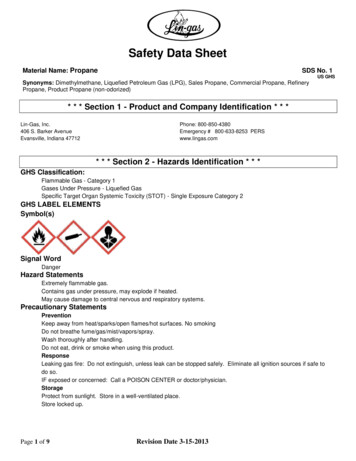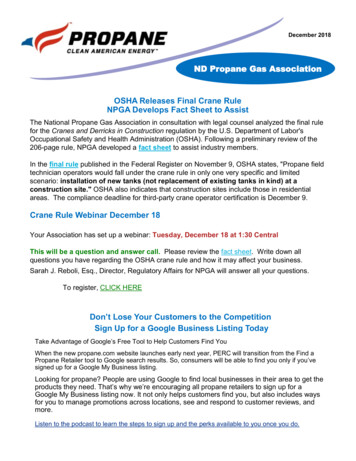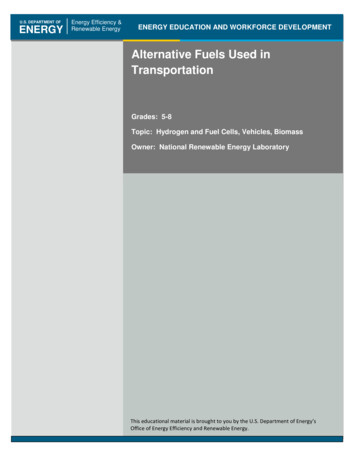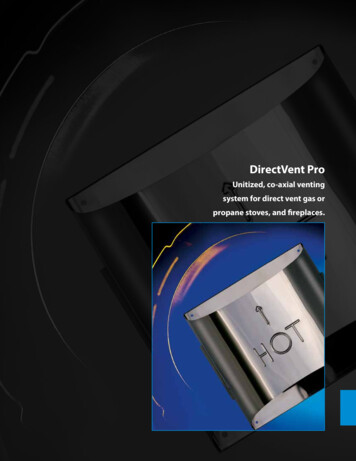
Transcription
catalystsArticleTransformation of Propane over ZnSnPt ModifiedDefective HZSM-5 Zeolites: The Crucial Role ofHydroxyl Nests ConcentrationWei Zhou, Jiaxu Liu *, Jilei Wang, Long Lin, Ning He, Xiaotong Zhang and Hongchen GuoState Key Laboratory of Fine Chemicals & School of Chemical Engineering, Dalian University of Technology,Dalian 116012, China* Correspondence: liujiaxu@dlut.edu.cn; Tel./Fax: 86-411-8498-6162Received: 11 May 2019; Accepted: 27 June 2019; Published: 28 June 2019 Abstract: A series of ZnSnPt supported defective MFI zeolites with different SiO2 /Al2 O3 ratios (30, 110,700, and ) and hydroxyl nests concentration were prepared and characterized by multiple techniquesincluding scanning electron microscopy (SEM), nitrogen physisorption, NH3 -TPD, transmissionelectron microscopy (TEM), hydrogen temperature programmed reduction (H2 -TPR), and Fouriertransform infrared spectrometer (FT-IR). It was found that Brønsted acid sites (Si(OH)Al) with strongacid strength and the hydroxyl nests with weak acid strength coexisted over the defective ZSM-5zeolites and ZnSnPt Lewis acid sites preferentially located on the hydroxyl nests. The increase inthe concentration of hydroxyl nests and SiO2 /Al2 O3 ratios apparently improved the distributionof ZnSnPt Lewis acid sites. The hydroxyl nest incorporated ZnSnPt Lewis acid sites showedextraordinary dehydrogenation ability. Specially, operando dual beam Fourier transform infraredspectrometer (DB-FTIR) was applied to characterize the propane transformation under reactionconditions. At low SiO2 /Al2 O3 ratios, the propane efficiently transforms into propene and aromatics(total selectivity of 93.37%) by the cooperation of Brønsted acid sites and ZnSnPt Lewis acid sites.While at high SiO2 /Al2 O3 ratios, the propane mainly transforms into propene (selectivity of above95%) and hydrogen. This study provides guidance for the preparation of highly efficient propanedehydrogenative transformation catalyst.Keywords: defective MFI; hydroxyl nests; ZnSnPt Lewis acid sites; Si(OH)Al; operando dual beamFT-IR spectroscopy1. IntroductionEnvironmentally friendly and non-corrosive, solid acid catalysts (zeolites and zeolite-basedcatalysts) have been widely applied in numerous petrochemical processes [1]. A “hydroxyl-nestdefect” over the silica–alumina zeolites was first produced by progressively removing the aluminumfrom the frameworks and substituting with nests of four hydroxyls [2]. Although the hydroxylnests possess mild acidic properties [3–5], the catalytic function of the hydroxyl nests are seldomreported and merely testified to be effective in the Beckmann rearrangement [6–8]. The HZSM-5 zeolitewith MFI topology has been widely employed in applications such as cracking, dehydrogenation,oligomerization, and aromatization due to their large surface area, excellent reactivity and stability,unique pore structure, and shape selectivity [9,10]. Usually, the upgrading of its catalytic performancedepends on the posttreatments to adjust the acidic properties [11–14]. On account of the weak acidityof the hydroxyl nests, it provides another way for the designing of novel catalysts in heterogeneousreactions by regulating the ratio of hydroxyl nests to Si(OH)Al groups.Catalysts 2019, 9, 571; ysts
Catalysts 2019, 9, 5712 of 13High-efficiency transformation of light alkanes is one of the greatest challenges of the presentcatalysis research. The introduction of Zn, Ga, and Pt species into HZSM-5 improved thedehydrogenative aromatization performance and inhibited the cracking of side-reactions [13,15–18].The Cyclar process was jointly developed by BP and UOP using Ga–Pt modified ZSM-5 zeolite as thecatalyst [19]. When propane was used as a feedstock, the aromatics yield announced was 63.1 wt%and the dry gas yield was 31 wt%. Nevertheless, the extremely high selectivity of the by-products andhigh cost of Ga–Pt modification catalysts hampered its further development. According to literatureand our previous work, Zn modified HZSM-5 zeolites are effective catalysts for the dehydrogenativearomatization of light alkanes and exhibit comparable catalytic performance to Ga–Pt loaded ZSM-5zeolite [20–31]. However, the generation of substantial amounts of dry gas (methane and ethane)by-products has inhibited the large-scale application of the light alkanes dehydrogenative aromatizationover the Zn supported HZSM-5 zeolite [32–35]. According to our previous study [36], the addition ofSnPt into Zn/HZSM-5 apparently improved the propane dehydrogenative aromatization performance.However, due to the low SiO2 /Al2 O3 ratio of HZSM-5, the Brønsted acidity and metal dispersion werenot at the optimal status. Moreover, we found that Zn modified defective HZSM-5 catalysts obtainedbetter performance than regular HZSM-5 catalysts in hexane aromatization, and the hydroxyl groupstabilized Zn species exhibited better dehydrogenative performance [37].Therefore, in this study, a series of ZnSnPt modified defective MFI zeolites (ZSM-5 and silicalite-1)with different SiO2 /Al2 O3 ratios (30, 110, 700 and ) and hydroxyl nests concentration are systematicallystudied. It is found that ZnSnPt Lewis acid sites are preferentially located on the hydroxyl nests withweak acidity rather than on the Si(OH)Al groups with strong acidity, and the size of metal particles issmaller and much more uniform at higher concentration of the hydroxyl nests. These ZnSnPt Lewisacid sites located on the hydroxyl-nest defects show superior propane dehydrogenation performance.For the ZnSnPt modified HZSM-5 zeolite with low SiO2 /Al2 O3 ratio of 30, the selectivity of propyleneand BTX (benzene, toluene, xylene) is 52.92% and 40.45%, respectively, while the selectivity of C1 –C2alkanes is only 6.63%. For the ZnSnPt modified HZSM-5 zeolite with high SiO2 /Al2 O3 ratio of ,propane mainly transforms into propene (above 95% selectivity) and hydrogen. Operando dual beamFourier transform infrared spectrometer (FTIR) study unravels that the acidity of neighboring activesites over ZnSnPt Lewis acid sites located hydroxyl nests determines the transformation paths.2. Results and Discussion2.1. Defective MFI Zeolites Supported by Zn–Sn–Pt with Different SiO2 /Al2 O3 RatiosAs shown in the scanning electron microscopy (SEM) images in Figure 1, the introduction of Zn,Sn, Pt into HZSM-5 zeolites with different SiO2 /Al2 O3 ratios by impregnation has little influence on thecrystal size and morphology (Figure 1). According to the XRD (X-ray diffraction) patterns shown inFigure S1, five characteristic diffraction peaks of the MFI structure are preserved [5] and no diffractionsignals for metal species are observed, indicating that the metal species are highly dispersed.
Catalysts 2019, 9, 5713 of 13Catalysts 2019, 9, x FOR PEER REVIEW3 of 131. ScanningFigure 1.Scanning electronelectron microscopymicroscopy (SEM)(SEM) imagesimages ofof defectivedefective MFIMFI zeolites with SiO22/Al22OO3 ratios. (a) HZ30, (b) HZ110, (c) HZ700, (d) S-1.According to the nitrogen physisorption results (Table 1), some important specifics related tothe locations of Zn, Sn, and Pt on the ZnSnPt/MFI catalysts are found. TheThe external surface area andthe mesoporosity of ZnSnPtZnSnPt modifiedmodified defectivedefective MFIMFI catalystscatalysts obviouslyobviously decreaseddecreased comparedcompared withthat of thethe parentparent zeolites.zeolites. The external surface of the parent nano-MFI crystals in the aggregatesaggregatesformed the inter-crystal mesopores as revealed by the pore size distributiondistribution (Figure(Figure 2).2). After themodification with Zn, Sn and Pt species,species, thethe inter-crystalinter-crystal mesoporesmesopores apparentlyapparently decreased.decreased. Based onthe tedexternalsurfacethecatalysts.Moreover,it canbe beseenthatareaandandporeporecapacityof microporesof thecatalysts.Moreover,it canseenthatthethespecificspecificsurfacesurface areacapacityof microporesalsoalsodecreaseafter loadingIt is reasonabletothatdeducesomeof themetalZnSnPtmetalareparticlesdecreaseafter loadingZnSnPt.ZnSnPt.It is reasonableto deducesomethatof theZnSnPtparticleslocatedarelocatedinsidethe zeolite channels.insidethe zeolitechannels.Tablepropertiesof theparentand Zn–Sn–PtmodifieddefectiveMFI zeolitesdifferentTable 1.1.TexturalTexturalpropertiesof theparentand Zn–Sn–PtmodifieddefectiveMFI withzeoliteswithSiO2 /Al2 O3 ratios.2/Al2O3 ratios.differentSiOSampleSampleSiOSiO2/Al2O32 O330302 /Ala a425SBETSBET425b bSmicro334334Smicrob robVmicro0.23Vmeso c0.12Vmeso c0.12HZSM-5HZSM-5110110 700700342380342380232232 232232110 1481481100.27 0.280.280.270.14 0.140.14 0.140.13 0.140.130.14bZnSnPt/HZSM-5ZnSnPt/HZSM-5 44344336436479790.300.300.160.160.140.14110 700700 3030 110364 291291 293293 354354364310 212212 196196 3243243105454 7979 97 97 30 300.240.24 0.230.23 0.210.21 0.220.220.18 0.13 0.13 0.120.18 0.13 0.13 0.120.06 0.10 0.08 0.100.060.100.080.10BET method applied to the N2 isotherm. t-Plot method applied to the N2 isotherm. c V meso V pore V micro .b t-Plot method applied to the N2 isotherm. c V meso Vpore BETwasmethodappliedtheamountN2 isotherm.V poredeterminedfromtotheof N2 adsorbedat p/p0 0.99.aaVmicro. Vpore was determined from the amount of N2 adsorbed at p/p0 0.99.
Catalysts 2019, 9, 571Catalysts 2019, 9, x FOR PEER REVIEW4 of 134 of 130.053 -13 Pt/HZ700ZnSnPt/S-10.04-10.04dV/d(logD) (cm g nm )HZ30HZ110HZ700S-1-1dV/d(logD) (cm g nm )0.050.030.020.010.0051015Pore width (nm)2025 30-0.01510152025 30Pore width (nm)Figure 2. Pore size distribution of defective MFI zeolites (a) and Zn–Sn–Pt modified defective MFIFigure 2. Pore size distribution of defective MFI zeolites (a) and Zn–Sn–Pt modified defective MFIzeolites (b) with different SiO2 /Al2 O3 ratios.zeolites (b) with different SiO2/Al2O3 ratios.2.2. Metallicity of ZnSnPt Lewis Acid Sites over Defective MFI Zeolites with Different SiO2 /Al2 O3 Ratios2.2. Metallicity of ZnSnPt Lewis Acid Sites over Defective MFI Zeolites with Different SiO2/Al2O3 RatiosTEM was carried out to obtain the direct information about metal dispersion on ZnSnPt/MFITEMcarried inoutFigureto obtaintheaveragedirect informationmetalisdispersioncatalysts. wasAs shown3, thesize of metalaboutparticleslarger thanon4 ZnSnPt/MFInm over thecatalysts.As showninMoreover,Figure 3, ittheaveragesizetheof metalmetaldispersionparticles islargerenhancedthan 4 nmtheZnSnPt/HZ30catalyst.wasfound asfoundthatthemetaldispersionfurtherenhancedwithin the SiO2 esdecreasedto0–3nmcenteringatless2 etalparticlesdecreasedto0–3nmcenteringthan 2 nm. These results suggest that small-sized metal particles are obtained at a high concentrationatthan 2nests,nm. asThesesuggestsmall-sizedmetala highof lesshydroxylseenresultsin Figure3d. Hthatis performedto particlesillustrate arethe obtainedinteractionatbetween2 H2-TPRisperformedtoillustratetheKthe metals. In Figure S2, SnPt/HZ30 catalyst has only one hydrogen consumption peak at 645interactionbetweenthe andmetals.In FigureS2,ThisSnPt/HZ30catalysthas theonlyformationone hydrogenthat is f SnPtconsumptionat SnPt/HZ30645 K that catalyst.is alloy particlespeakon theBasedon ourpreviouswork[38], thereno hydrogensuggeststhe formationofZn/HZ30SnPt alloyparticlesthe SnPt/HZ30catalyst.Basedourpreviousconsumptionpeak on thecatalyst,andona hydrogenconsumptionpeakat a onhightemperaturework[38], tothereis nohydrogenconsumptionon the Zn/HZ30catalyst,a hydrogenattributedstronginteractionbetweenthe zincpeakand platinumspecies ofZn1.0 Ptandcatalyst.0.1 stronginteractionbetweenthezincandAs shown in Figure 4, there are two hydrogen consumption peaks over the ZnSnPt modified AsshowninFigure4,therearetwohydrogenMFI zeolites: One at around 633 K, which is associated with the formation of SnPt alloys; and theconsumptionover the cOneandat around633species.K, whichisother at a eotheratahightemperature,whichshowsthe H2 -TPR characterization provided more convincing evidences for the formation of SnPt alloys andstronginteractionbetweenzinc andplatinumspecies.Thus, the H2-TPR characterization providedthe interactionbetweenplatinumandsmall ZnOcluster.more convincing evidences for the formation of SnPt alloys and the interaction between platinumand small ZnO cluster.
Catalysts2019,2019,9,9,571x FOR PEER REVIEWCatalystsCatalysts 2019, 9, x FOR PEER REVIEW55 ofof 13135 of 13Figure 3. TEM images and particles size distribution of Zn–Sn–Pt modified defective MFI zeolitesFigure 3.and particlessizedistributionof Zn–Sn–PtmodifieddefectiveMFI MFIzeoliteswithFigure3. TEMTEM ieddefectivezeolites2O3 particlesratios. h differentSiO2/Alanddifferent SiO2 /Al2 O3 ratios. (a) ZnSnPt/HZ30, (b) ZnSnPt/HZ110, (c) ZnSnPt/HZ700, (d) ZnSnPt/S-1withdifferentSiO2/Al2O3 ratios. (a) ZnSnPt/HZ30, (b) ZnSnPt/HZ110, (c) ZnSnPt/HZ700, (d)ZnSnPt/S-1catalysts.catalysts.ZnSnPt/S-1 catalysts.Figure 4. H2 -TPR profiles of ZnSnPt modified defective MFI zeolites. (a) ZnSnPt/HZ30;Figure 4. H2-TPR profiles of ZnSnPt modified defective MFI zeolites. (a) ZnSnPt/HZ30; (b)(b) ZnSnPt/HZ110; (c) ZnSnPt/HZ700; (d) ZnSnPt/S-1.Figure4. H2-TPRprofiles of ZnSnPtmodified defective MFI zeolites. (a) ZnSnPt/HZ30; (b)ZnSnPt/HZ110;(c) ZnSnPt/HZ700;(d) ZnSnPt/S-1.ZnSnPt/HZ110; (c) ZnSnPt/HZ700; (d) ZnSnPt/S-1.2.3. Acidity of ZnSnPt Lewis Acid Sites over Defective MFI Zeolites with Different SiO2/Al2O3 Ratios2.3. Acidity of ZnSnPt Lewis Acid Sites over Defective MFI Zeolites with Different SiO2/Al2O3 Ratios
Catalysts 2019, 9, 571Catalysts 2019, 9, x FOR PEER REVIEW6 of 136 of 13The acidityof thesecharacterizedbyZeolitesthe FTIRthesurfacehydroxyl2.3. Acidityof ZnSnPtLewissamplesAcid SitesisoverDefective MFIwithspectraDifferentofSiO2 /Al2 O3 Ratios(OH-FTIR), NH3-TPD (Figures 5 and 6), and pyridine adsorbed FTIR spectra (Py-FTIR) (Figure S3).The acidity of these samples is characterized by the FTIR spectra of the surface hydroxyl (OH-FTIR),OH-FTIR spectra suggested that the defective ZSM-5 contained Brønsted acid groups (3610 cm-1)NH3 -TPD (Figures 5 and 6), and pyridine adsorbed FTIR spectra (Py-FTIR) (Figure S3). OH-FTIRassociated with framework aluminum (Si(OH)Al), isolated external silanol groupscm-1), free 1 )(3740spectra suggested that the defective-1ZSM-5 contained Brønsted acid groups (3610 cmassociatedwithinternal silanol groups (3720 cm ), and hydroxyl nests (at around 3500 1cm-1) that consist of aframework aluminum (Si(OH)Al), isolated external silanol groups (3740 cm ), free internal silanolnumber of silanolgroups interacting through extended hydrogen bonding [3,34,39]. Thegroups (3720 cm 1 ), and hydroxyl nests (at around 3500 cm 1 ) that consist of a number of silanolmodification of the MFI zeolites with Zn, Sn and Pt species led the Brønsted acid sites and hydroxylgroups interacting through extended hydrogen bonding [3,34,39]. The modification of the MFI zeolitesnests to simultaneously decrease. However, the decreasing of hydroxyl nests is much morewith Zn, Sn and Pt species led the Brønsted acid sites and hydroxyl nests to simultaneously decrease.significant suggesting that the ZnSnPt is mainly located in the hydroxyl nests. Moreover, withHowever, the decreasing of hydroxyl nests is much more significant suggesting that the ZnSnPt isincrease in the SiO2/Al2O3 ratios, the relative distance between the acid sites and ZnSnPt active sitesmainly located in the hydroxyl nests. Moreover, with increase in the SiO2 /Al2 O3 ratios, the relativealso increased.distance between the acid sites and ZnSnPt active sites also increased.Figure 5.5. OH-FT-IROH-FT-IR spectraspectra ofof parentparent andand Zn–Sn-PtZn–Sn-Pt modifiedmodified defectivedefective MFIMFI zeoliteszeolites withwith 019,2/Al29,Ox3 FORratios.HZ30 and ZnSnPt/HZ30; (b) HZ110 and ZnSnPt/HZ110; (c) HZ700;CatalystsPEER(a)REVIEW7 of 13ZnSnPt/HZ700;(d)S-1andZnSnPt/S-1.ZnSnPt/HZ700; (d) S-1 and HZ30Generally, theHZSM-5zeolites havetwo typical desorptiona NH3-TPD profiles of defectivebZnSnPt/HZ110HZ110peaks: one centered at about 230 C and the other at 400 C. The low temperature peak is associatedZnSnPt/HZ700HZ700with acid sites obtaining weak acidity [40,41]. The high temperature peakis associated with acidZnSnPt/S-1S-1sites obtaining strong acidity. Due to the existence of Si(OH)Al groups with strong acid strength,the Zn modification also converts these Si(OH)Al groups with strong acidity into acid sites withmedium and weak acidity. Thus, the overall amount of weak acid sites obtained by NH3-TPDprofiles shows no decrease. Only a slight signal of NH3 desorption is obtained over the S-1 zeolite,demonstrating its weak acidic character. Over ZnSnPt/S-1 catalyst, the signals of NH3 desorption ofthe samples with ZnSnPt modification are strong that shows the stability of the Zn species on thehydroxyl nests can enhance the acidity of the ZnSnPt/S-1 zeolite.In addition, Py-FTIR spectroscopy was carried out to follow the transformation of Brønstedand Lewis acid100sites 200during300the catalystspreparation.to theof HZ110400500600 100 According200300400Py-FTIR500 spectra600-1and ZnSnPt/HZ110 in Figure T/S3,at 1435 cm attributed to the Cit can be seen that the absorbanceT/ CLewis acid sites of the hydroxyl nests disappeared and a new peak that was attributed to the ZnFigure 6. (a) The NH3 -TPD profiles -1of defective MFI zeolites with different SiO2 /Al2 O3 ratios;LewisFigureacid 6.sitesappearedat profiles1450 cmSimilar MFIphenomenaswerealso SiOobservedfor the(b)other(a) TheNH3-TPDof .defectivezeolites withdifferent2/Al2O3 ratios;(b) Zn–Sn–Pt modified defective MFIzeolites with different SiO2 /Al2 O3 ratios.-1 attributed to the Brønstedsamples.The absorbanceat 1540MFIcmzeolitessites, still existed after loading3 ratios.Zn–Sn–Ptmodified defectivewith different SiO2/Al2Oacidthe metalsoverthetheseTherefore,accordingto theOH-IRandresults,the metalsGenerally,NH3samples.-TPD profilesof os C andpreferentiallyon thehydroxylnestsweakacidity.one centered atlocatedabout 230the otherat showed400 C. Thelowtemperature peak is associated 3withacidsites Theobtainingweakacidity [40,41].The highpeak isassociatedwithacid sitescatalyticperformanceof parentand temperatureZnSnPt hstrongacidstrength,theZnmodificationSiO2/Al2O3 ratios was tested by propane transformation. In Figure 7, it is obvious that the ZnSnPtalso convertsthese Si(OH)Algroupswith betterstrong catalyticacidity intoacid sites withand zeolites.weak acidity.modifieddefectiveMFI zeolitesexhibitperformancethanmediumthe parentTheThus,theweak acidsitesobtainedbylittleNH3significant-TPD profilesshowsnopropanedecrease.productOnly aSiO2/Al2Ooverall3 ratios amountof parentofdefectiveMFIzeoliteshaveeffecton theslight signal ofTheNHselectivityobtainedtransformationover the S-1 zeolite,weak affectedacidic character.distribution.in ispropaneover demonstratingMFI zeolites isitshighlyby the3 desorptionconversion degree and by the extension of consecutive reactions. The conversion of propane over theparent MFI zeolites with different SiO2/Al2O3 ratios is low. At low conversion levels, propaneundergoes cracking reaction with large amount of methane, ethane, and ethylene as main products.These results suggest that the ability of the ZSM-5 parent zeolites to activate propane is poor. Athigher conversion levels, the activation by the hydride transfer mechanism predominates due to the
Catalysts 2019, 9, 5717 of 13Over ZnSnPt/S-1 catalyst, the signals of NH3 desorption of the samples with ZnSnPt modification arestrong that shows the stability of the Zn species on the hydroxyl nests can enhance the acidity of theZnSnPt/S-1 zeolite.In addition, Py-FTIR spectroscopy was carried out to follow the transformation of Brønsted andLewis acid sites during the catalysts preparation. According to the Py-FTIR spectra of HZ110 andZnSnPt/HZ110 in Figure S3, it can be seen that the absorbance at 1435 cm 1 attributed to the Lewis acidsites of the hydroxyl nests disappeared and a new peak that was attributed to the Zn Lewis acid sitesappeared at 1450 cm 1 . Similar phenomenas were also observed for the other samples. The absorbanceat 1540 cm 1 attributed to the Brønsted acid sites, still existed after loading the metals over thesesamples. Therefore, according to the OH-IR and Py-IR results, the metals preferentially located on thehydroxyl nests showed weak acidity.2.4. Catalytic Performance of Zn–Sn–Pt Modified Defective MFI Zeolites with Different SiO2 /Al2 O3 RatiosThe catalytic performance of parent and ZnSnPt modified defective MFI zeolites with differentSiO2 /Al2 O3 ratios was tested by propane transformation. In Figure 7, it is obvious that theZnSnPt modified defective MFI zeolites exhibit better catalytic performance than the parent zeolites.The SiO2 /Al2 O3 ratios of parent defective MFI zeolites have little significant effect on the propaneproduct distribution. The selectivity in propane transformation over MFI zeolites is highly affectedby the conversion degree and by the extension of consecutive reactions. The conversion of propaneover the parent MFI zeolites with different SiO2 /Al2 O3 ratios is low. At low conversion levels, propaneundergoes cracking reaction with large amount of methane, ethane, and ethylene as main products.These results suggest that the ability of the ZSM-5 parent zeolites to activate propane is poor. At higherconversion levels, the activation by the hydride transfer mechanism predominates due to the formationof BTX [42]. The conversion of propane is enhanced significantly after the incorporation of Zn,Sn, and Pt species. The hydroxyl nest incorporated ZnSnPt Lewis acid sites showed extraordinarydehydrogenation ability. Over ZnSnPt/MFI catalysts, the decrease in the propane conversion withincreasing SiO2 /Al2 O3 ratios is caused by the reduction in the number of Brønsted acid sites, whichweakens the interaction between Brønsted acid sites and the metal Lewis acid sites. The selectivityof propylene increases with the SiO2 /Al2 O3 ratio of MFI zeolites. For ZnSnPt/HZ700, the propaneconversion and propylene selectivity is 24.35% and 98.51%, respectively. Moreover, for ZnSnPt/S-1,the propane conversion and propene selectivity is 19.05% and 96.43%, respectively. For ZnSnPt/HZ30,the selectivity of propylene and aromatics is 40.45% and 52.92%, respectively, and the selectivity ofC1 –C2 alkanes is only 6.63%, suggesting that when Brønsted acid sites are in close proximity to the highdispersion of metal clusters that are stably located on the hydroxyl nests, propane dehydrogenativearomatization occurred by synergistic catalysis between them.In the propane aromatization process, the Brønsted acid sites are responsible for the oligomerizationand cyclization, while Lewis acid sites catalyze the dehydrogenation of alkanes and cycloalkeneintermediates. It is indicated that the difference in the propane transformation of ZnSnPt/MFI zeoliteswith various hydroxyl nests concentration should be not only attributed to their different acidity,but also sensitive to the relative positions of different active centers. Regardless of this, an appropriateratio between Brønsted acid sites and hydroxyl nests concentration of ZnSnPt/MFI catalysts can improvethe selectivity of aromatics. However, a significant decrease in proximity between the Brønsted acidsites and the other active species inhibits the oligomerization and aromatization of olefins, converselyincreasing the propylene selectivity.
Catalysts 2019, 9, 571Catalysts 2019, 9, x FOR PEER REVIEW8 of 138 of 13Figure 7. The performance of defective MFI zeolites (a, a′) and Zn-Sn-Pt modified defective MFIzeolites (b, b′) with different SiO2/Al2O3 ratios in propane transformation with a fixed-bed reactor. (T 610 C, GHSV 1800 h-1, atmospheric /h2030ZnSnPt/HZ30ZnSnPt/HZ110T 610 C, atmosphericZnSnPt/HZ700Figure 8. Stability test on ZnSnPt/MFI catalyst with different SiO2 /Al2 O3 ratios.40 2ofFigure8.GHSVStabilitytesth 1onZnSnPt/MFIcatalystwith differentSiO2/AlO3C3ratios.610 C,pressure, 1800. (a)The conversionof propane;(b)ZnSnPt/HZ30the selectivityH6 ; (c) Tthe selectivity7560ZnSnPt/HZ110-1. (a) The conversion ofpropane;(b)theselectivityofC3H6; (c)atmosphericpressure,GHSV 1800hof aromatics.ZnSnPt/HZ70030ZnSnPt/S-1the selectivity of aticsSelectivity-S%-C3H6Conversion-X%-C3H8In the propane aromatization process, the Brønsted acid sites are responsible for theoligomerization and cyclization, while Lewis acid sites catalyze the dehydrogenation of alkanes andcycloalkene intermediates. It is indicated that the difference in the propane transformation ofZnSnPt/MFI zeolites with various hydroxyl nests concentration should be not only attributed totheir different acidity, but also sensitive to the relative positions of different active 0(a,) andmodifieddefectiveMFI zeolitesFigure -Ptand Zn-Sn-PtmodifiedMFInestsRegardlessthis,an appropriateratiobetweenBrønstedacidsitesand defectivehydroxyl0(b,b) withdifferentSiO2 /Al2 Oin3 ratiospropanetransformationwith a fixed-bedreactor. (Treactor. 610 es(b, ofb′) withdifferentSiO3 ratiosconcentrationZnSnPt/MFIcatalystscan inimprovetheselectivityof aaromatics.However,a 1 , atmospheric-1, atmosphericGHSV 1800hpressure).pressure.). 610 C,GHSV 1800hsignificant decrease in proximity between the Brønsted acid sites and the other active species inhibitsthe oligomerization and aromatization of olefins, conversely increasing the propylene selectivity.In orderto further investigate theprocess,stability ofZnSnPt/MFIcatalysts,30 h responsiblecontinuous propaneInthe propanetheZnSnPt/MFIBrønsted catalysts,acidsitesaa 30arefor theInorderto furtheraromatizationinvestigate the stability ofh continuous erizationwasandperformed.cyclization,Figurewhile 8Lewisacid thatsitesthecatalyzethe of propane and nSnPt/MFI catalystswith differentSiOdifferenceare stableduring30 h test.2 /Al2 O3 ratioscycloalkeneis indicatedthat thein thepropanetransformationofproducts overZnSnPt/MFIItcatalystswith differentSiO2/Al2O3 ratiosarestable during30 h test. ofZnSnPt/MFI zeolites with various hydroxyl nests concentration should be not only attributed to100105theiralso bsensitiveto the relative positionsc 60 of different active centers.ZnSnPt/HZ30a different acidity, butZnSnPt/HZ110Regardless of this, an ZnSnPt/HZ700appropriate ratio between Brønsted acid sites and 10concentration of ZnSnPt/MFI catalysts can improve the selectivity of aromatics. However, aZnSnPt/HZ700significant decrease in proximity between the Brønsted acidZnSnPt/HZ30sites and the40 other active species inhibits7560ZnSnPt/HZ110the oligomerizationand aromatization of olefins, converselyincreasing the propylene selectivity.ZnSnPt/HZ70030ZnSnPt/S-1In order to further investigate the stability of ZnSnPt/MFI catalysts, a 30 h continuous propane6040transformationwas performed. Figure 8 suggests that the conversion 20of propane and the selectivityof products over ZnSnPt/MFI catalysts with different SiO2/Al2O3 ratios10are stable during 30 h test.60Operando DB-FTIR was employed to reveal the catalytic functions20 of ZnSnPt/MFI zeolites withdifferent SiO2 /Al2 O3 ratios (30, 110, 700, and ) and hydroxyl nests 10concentration under propane4520reactionconditions. In order to get more detailed information, the selected FT-IR profiles (1350–1650,02800–3050,andcm 130) are displayedinthat, in 0contrast10to ZnSnPt010 3300–380020010 Figure209. Note 3020 modified30TOS/hTOS/hTOS/hdefective MFI zeolitesof high SiO2 /Al2 O3 ratios, propane is more strongly adsorbed over ZnSnPt/HZ30catalyst. As the temperature of propane adsorption enhanced, the absorbance of Si(OH)Al group at8. Stabilitytest on 2O3 ratios.T participated610 C,3610 Figurecm 1 obviouslydecreased9a (1)),which withindicatedthat theacid sites-1. (a) The conversion of propane; (b) the selectivity of C3H6; (c)atmosphericpressure,GHSV 1800hin the propane transformation. However, the initial step on metal clusters through propane dissociativethe selectivity of aromatics.
conditions. At low SiO2/Al2O3 ratios, the propane e ciently transforms into propene and aromatics (total selectivity of 93.37%) by the cooperation of Brønsted acid sites and ZnSnPt Lewis acid sites. While at high SiO2/Al2O3 ratios, the propane mainly transfo










